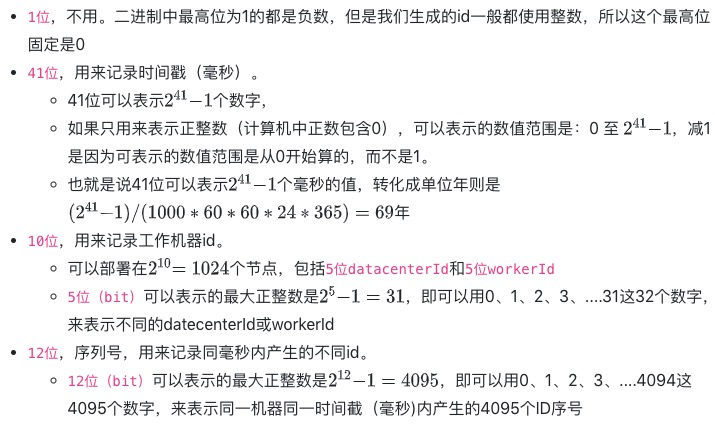JS 雪花算法生成随机 ID
生成一个随机的 ID 有很多种做法,比如说 GUID 和 UUID。但如果想要有序,可以插入数据库中做数字主键,那就有了雪花算法。雪花算法得到的是个比较大的数字,比较大,而 JS 中 Number 类型的最大值 Number.MAX_SAFE_INTEGER:9007199254740991,那这样运算会溢出。所幸的是网上有很多 BigInt 的类库,现在 ES10 标准就包括了它,并且 Chrome 67 也实现了支持。
原理
下图出自理解分布式id生成算法
SnowFlake算法生成id的结果是一个64bit大小的整数,它的结构如下图:


代码
var Snowflake = (function() {
function Snowflake(_workerId, _dataCenterId, _sequence) {
this.twepoch = 1288834974657n;
//this.twepoch = 0n;
this.workerIdBits = 5n;
this.dataCenterIdBits = 5n;
this.maxWrokerId = -1n ^ (-1n << this.workerIdBits); // 值为:31
this.maxDataCenterId = -1n ^ (-1n << this.dataCenterIdBits); // 值为:31
this.sequenceBits = 12n;
this.workerIdShift = this.sequenceBits; // 值为:12
this.dataCenterIdShift = this.sequenceBits + this.workerIdBits; // 值为:17
this.timestampLeftShift = this.sequenceBits + this.workerIdBits + this.dataCenterIdBits; // 值为:22
this.sequenceMask = -1n ^ (-1n << this.sequenceBits); // 值为:4095
this.lastTimestamp = -1n;
//设置默认值,从环境变量取
this.workerId = 1n;
this.dataCenterId = 1n;
this.sequence = 0n;
if (this.workerId > this.maxWrokerId || this.workerId < 0) {
throw new Error('_workerId must max than 0 and small than maxWrokerId-[' + this.maxWrokerId + ']');
}
if (this.dataCenterId > this.maxDataCenterId || this.dataCenterId < 0) {
throw new Error('_dataCenterId must max than 0 and small than maxDataCenterId-[' + this.maxDataCenterId + ']');
}
this.workerId = BigInt(_workerId);
this.dataCenterId = BigInt(_dataCenterId);
this.sequence = BigInt(_sequence);
}
Snowflake.prototype.tilNextMillis = function(lastTimestamp) {
var timestamp = this.timeGen();
while (timestamp <= lastTimestamp) {
timestamp = this.timeGen();
}
return BigInt(timestamp);
};
Snowflake.prototype.timeGen = function() {
return BigInt(Date.now());
};
Snowflake.prototype.nextId = function() {
var timestamp = this.timeGen();
if (timestamp < this.lastTimestamp) {
throw new Error('Clock moved backwards. Refusing to generate id for ' +
(this.lastTimestamp - timestamp));
}
if (this.lastTimestamp === timestamp) {
this.sequence = (this.sequence + 1n) & this.sequenceMask;
if (this.sequence === 0n) {
timestamp = this.tilNextMillis(this.lastTimestamp);
}
} else {
this.sequence = 0n;
}
this.lastTimestamp = timestamp;
return ((timestamp - this.twepoch) << this.timestampLeftShift) |
(this.dataCenterId << this.dataCenterIdShift) |
(this.workerId << this.workerIdShift) |
this.sequence;
};
return Snowflake;
}());
注意代码中的 this.twepoch = 1288834974657n;。如果 ((timestamp - 1288834974657) << 32) 超过long类型数据范围,怎么办?可以保证69年不超,1288834974657这个初始值是可以设置的。
使用如下
console.time();
var tempSnowflake = new Snowflake(1n, 1n, 0n);
var tempIds = [];
for (var i = 0; i < 10000; i++) {
var tempId = tempSnowflake.nextId();
console.log(tempId);
if (tempIds.indexOf(tempId) < 0) {
tempIds.push(tempId);
}
}
console.log(tempIds.length);
console.timeEnd();
附录-GUID/UUID
原文:https://www.cnblogs.com/snandy/p/3261754.html
全局唯一标识符(GUID,Globally Unique Identifier)也称作 UUID(Universally Unique IDentifier) 。
GUID是一种由算法生成的二进制长度为128位的数字标识符。GUID 的格式为“xxxxxxxx-xxxx-xxxx-xxxx-xxxxxxxxxxxx”,其中的 x 是 0-9 或 a-f 范围内的一个32位十六进制数。在理想情况下,任何计算机和计算机集群都不会生成两个相同的GUID。
GUID 的总数达到了2128(3.4×1038)个,所以随机生成两个相同GUID的可能性非常小,但并不为0。GUID一词有时也专指微软对UUID标准的实现。
function guid() {
return 'xxxxxxxx-xxxx-4xxx-yxxx-xxxxxxxxxxxx'.replace(/[xy]/g, function(c) {
var r = Math.random() * 16 | 0, v = c == 'x' ? r : (r&0x3 | 0x8);
return v.toString(16);
});
}
由于在Java中64bit的整数是long类型,所以在Java中SnowFlake算法生成的id就是long来存储的。
SnowFlake可以保证:
- 所有生成的id按时间趋势递增
- 整个分布式系统内不会产生重复id(因为有datacenterId和workerId来做区分)





